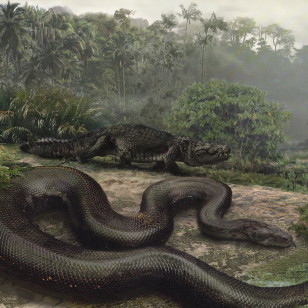An international group of researchers found in northeastern Colombia the fossils of a snake 13 meters long and weighing 1.25 tons, the information sheds light on the environmental conditions in the equatorial region 60 million years ago

According to University of Toronto researchers, the snake is the length of an average passenger bus and weighs more than a passenger car, making it the largest snake the world has ever seen. The giant reptile weighed more than 1.25 tons and was 13 meters long, the dimensions of the snake were so large that it would not have been able to fit through a standard door.
The snake's scientific name is Titanoboa and it lived in the Paleocene Epoch, a period that lasted 10 million years, and followed the period when the dinosaurs were extinct. In the area of the discovery, many remains of giant deer and primitive alligators were found that were extinct - they were probably part of the snake's diet.
A co-researcher on the research team from the University of Florida and the Florida Museum of Natural History said the discovery provides valuable information about environmental conditions in the equatorial region at the time. Until now, the dense tropical forests of South America prevented the discovery of vertebrate fossils from the period 55 to 65 million years ago, which is why this discovery is so important - it is a rare and unique glimpse into the past.
Size does matter - since the body size of snakes and other cold-blooded snakes is determined by the temperature of their living areas, so for example nowadays in a warm area around the equator large snakes live and as you move away from the equator their size gets smaller. The researchers used the snake's massive dimensions to speculate what the environmental conditions were like in the same area 60 million years ago. According to its size, the researchers found that the seasonal temperature in South America in the equatorial region was 33 degrees Celsius, about 6 degrees warmer than today.
The findings were published in the issue of Nature magazine on February 5. According to the researchers, the discovery will serve as accurate models for predicting conditions that prevailed in the region in the past. In combination with other factors, a reconstruction of the period will be carried out, and it will help scientists understand how ecosystems react to weather changes and what happens when temperatures change. There is no doubt that this information is relevant to the climate change process taking place now.
As far as the size of the snake is concerned, the findings break records, even the most exaggerated estimates did not speak of such large dimensions. This is a longer snake than even Hollywood has dared to show in its horror movies. There is no doubt that this is a significant discovery.
Sources

9 תגובות
How big is the snake?
A snake is a top predator, meaning at the top of the food chain. This means that a very small part of the energy in the system reaches it, because the rest is wasted on the way. That is - if these are the predators in the ecosystem, it is strong because it also included producers (mostly plants) in abundance or with incredible reproductive capacity.
The question is - will global warming lead to an increase in primary production (after all, there is a connection between temperature and primary production), and as a result of this increase can we predict the development of massive predators (unless humans destroy them first)?
lion:
Your memory must be deceiving you
http://www.extremescience.com/BiggestSnake.htm
If my memory serves me correctly, anaconda snakes over 10 m long, maybe even 12, have been found.
light:
I agree with your point about the snake.
By the way - nowadays they have never found any snake that even comes close to this size.
Regarding the location of South America - she was just on her way home from a visit to Africa.
Until 100 million years ago it was still in one territorial sequence with Africa.
Since today the two continents are in the equatorial region - I assume that was the case then as well.
What are the chances that a giant mutant snake (relative to its kind) is the one that will actually petrify, be preserved for 55 million years and later be found by the researchers? Apparently snakes of this size were not that rare.
Where exactly was South America at that time? near the equator like today?
My snake is bigger
There are giants and mutations in nature. If you are familiar with this species, you surely know that these snakes have reached gigantic sizes of this size (over 10 meters and under 15, let's say). The giant snake is a one-time find and may not be indicative of the rule. Especially when it comes to strange models of all kinds in which all kinds of parameters are more or less established. All in all, this discovery is cool and opens up the imagination and perhaps expands the evolutionary flexibility on the one hand and the climate estimates on the other hand for those times - but it is not a discovery that can, in my opinion, be given much weight. It is anecdotal and interesting, but does not particularly promote science.
Greetings friends,
Ami Bachar